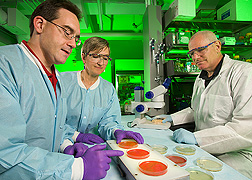New Methods for Detecting Listeria
Quick, accurate, cost-effective methods for detecting pathogenic bacteria are essential to ensuring a safe food supply. ARS scientists at the Eastern Regional Research Center (ERRC) in Wyndmoor, Pennsylvania, are improving methods to detect foodborne pathogens like the deadly Listeria monocytogenes.
The Centers for Disease Control and Prevsention estimates that listeriosis, the disease caused by L. monocytogenes infection, affects around 2,500 people every year and kills about 500. Newborns, seniors, pregnant women, and individuals with compromised or weakened immune systems are particularly susceptible.
Most methods for detecting harmful foodborne bacteria rely on antibodies, proteins used by the immune system to fight infections and foreign bodies. Because antibodies are highly specific, researchers can use them to identify and locate specific pathogens.
Antibodies vary in their degree of specificity. For example, current antibody-based methods for detecting L. monocytogenes can’t distinguish it from the mix of nonharmful bacteria found in most foods, says Shu-I Tu, research leader of the ERRC Microbial Biophysics and Residue Chemistry Research Unit.
A molecular method called “phage display” uses bacteria and bacterial viruses, or phages, to quickly select antibodies to detect pathogens. Microbiologist George C. Paoli and chemist Jeffrey D. Brewster have used phage display to isolate an antibody fragment that binds specifically to L. monocytogenes.
“This may be the first antibody to demonstrate the high degree of specificity required to accurately detect this pathogen,” Paoli says.
The researchers’ success demonstrates that antibody phage display can be used to select antibodies for pathogen detection—even where traditional methods have proved inadequate. Paoli is also using phage display to select antibodies targeting other difficult-to-detect bacterial pathogens related to food safety and security.
Paoli has since characterized the interaction of the antibody with the bacterium and has identified the part of the L. monocytogenes cell to which this antibody binds. Paoli and postdoctoral research associate Lynn Kleina also linked the antibody fragments to microscopic magnetic beads, creating an L. monocytogenes-specific immunomagnetic bead (IMB).
Because the antibodies bind to specific targets, the anti-L. monocytogenes IMBs can be used to capture just L. monocytogenes from the bacterial mix found in food. This is the first step in developing a significantly improved detection method for L. monocytogenes. This work will allow researchers to develop much-needed rapid tests for the pathogen, reducing the likelihood that contaminated food will reach consumers.
The Microbial Biophysics and Residue Chemistry Research Unit has an impressive history of pathogen detection research. To learn more about this work, see “New Detection Methods Improve Food Safety,” Agricultural Research, January 2005, pp. 15-17.—By Laura McGinnis, Agricultural Research Service Information Staff.
This research is part of Food Safety, an ARS National Program (#108) described on the World Wide Web at www.nps.ars.usda.gov.
Shu-I Tu is in the USDA-ARS Microbial Biophysics and Residue Chemistry Research Unit, Eastern Regional Research Center, 600 E. Mermaid Ln., Wyndmoor, PA 19038; phone (215) 233-6466, fax (215) 233-6581.
"New Methods for Detecting Listeria" was published in the October 2006 issue of Agricultural Research magazine.







